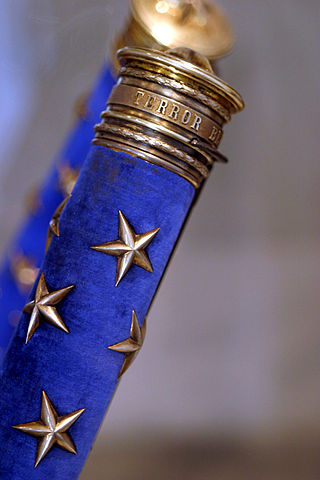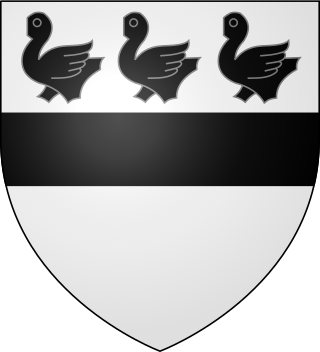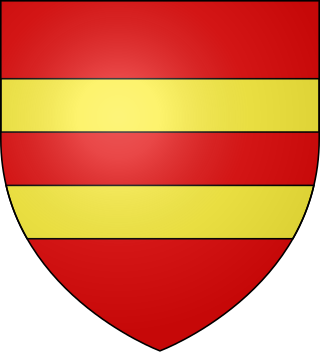
Marshal of France is a French military distinction, rather than a military rank, that is awarded to generals for exceptional achievements. The title has been awarded since 1185, though briefly abolished (1793–1804) and for a period dormant (1870–1916). It was one of the Great Officers of the Crown of France during the Ancien Régime and Bourbon Restoration, and one of the Grand Dignitaries of the Empire during the First French Empire.
Marshal General of France, originally "Marshal General of the King's camps and armies", was a title given to signify that the recipient had authority over all of the French armies, in the days when a Marshal of France usually governed only one army.

Duke of Châtellerault is a French noble title that has been created several times, originally in the Peerage of France in 1515. It takes its name from Châtellerault, in the Vienne region.

The House of Rohan is a Breton family of viscounts, later dukes and princes in the French nobility, coming from the locality of Rohan in Brittany. Their line descends from the viscounts of Porhoët and is said to trace back to the legendary Conan Meriadoc. Through the Porhoët family, the Rohans are related to the Dukes of Brittany, with whom the family intermingled again after its inception. During the Middle Ages, it was one of the most powerful families in the Duchy of Brittany. The Rohans developed ties with the French and English royal houses as well, and they played an important role in French and European history.

The Constable of France was lieutenant to the King of France, the first of the original five Great Officers of the Crown and the commander-in-chief of the Royal Army. He was, at least on paper, the highest-ranking member of the French nobility.

The Gardes du Corps du Roi was the senior formation of the King of France's household cavalry within the maison militaire du roi de France.
A Colonel General was an officer of the French army during the Ancien Régime, the French Revolution, the Napoleonic era and the Bourbon Restoration.
Jean VII d'Harcourt was a French nobleman. He was Count of Harcourt, Count of Aumale, Viscount of Châtellerault, and Seigneur of Mézières, of Elbeuf, of Lillebone, of La Saussaye etc.
Marie d'Alençon was a French noblewoman, a Princess of the Blood, and the wife of John VII of Harcourt, Count of Harcourt and of Aumale, Viscount of Châtellerault, Baron of Elbeuf, of Mézières, of Lillebone, of La Saussaye.
When the Viking chieftain Rollo obtained the territories via the Treaty of Saint-Clair-sur-Epte which would later make up Normandy, he distributed them as estates among his main supporters. Among these lands were the seigneurie of Harcourt, near Brionne, and the county of Pont-Audemer, both of which Rollo granted to Bernard the Dane, ancestor of the lords (seigneurs) of Harcourt. he first to use Harcourt as a name, however, was Anquetil d'Harcourt at the start of the 11th century.

The House of Beauharnais is a French noble family. It is now headed by the Duke of Leuchtenberg, descendant in male line of Eugène de Beauharnais.

The Galerie des Batailles is a gallery occupying the first floor of the Aile du Midi of the Palace of Versailles, joining onto the grand and petit appartement de la reine. 120 m (390 ft) long and 13 m (43 ft) wide, it is an epigone of the grand gallery of the Louvre and was intended to glorify French military history from the Battle of Tolbiac to the Battle of Wagram.

François de Montmorency-Bouteville was the second son of Louis de Montmorency, Comte de Bouteville, Vice-Admiral of France under Henri IV. In 1612, he became prior of Le Plessis-Grimoult in name, and in person in 1616. He remained prior until 1618 when he stepped down in favor of his brother Louis. François succeeded his brother Henri in 1616 and became Duke of Luxembourg and Governor of Senlis. He served with distinction at the sieges of Saint-Jean-d'Angély, Montauban, Royan and Montpellier.

Victurnien de Rochechouart, 10th Duke of Mortemart was a French general and politician. He came from the Mortemart branch of the house of Rochechouart, named after the barony of Mortemart in Haute-Vienne, later raised to a marquisate and finally in December 1650 to a peer-duchy.

Georges-Trevor-Douglas-Bernard d'Harcourt-Olonde was a French aristocrat and a 19th-century diplomat. Formally styled marquis d'Harcourt, he served as French Ambassador to London from 1875 until 1879.

Henri d'Harcourt, 1st Duke of Harcourt was a French noble, created the first Duke of Harcourt and Marshal of France by king Louis XIV. The duke also acted as extraordinary ambassador to Madrid.

Geoffroy d'Harcourt, called "the Lame", Viscount of Saint-Sauveur, was a 14th century French nobleman and prominent soldier during the early stages of the Hundred Years' War.
François d'Harcourt, 12th Duke of Harcourt was a French politician.

The Château d'Harcourt is a stately home dating from the 17th and 18th century, now in ruins, located in the village of Thury-Harcourt, in the Calvados department in the Normandy region in northwestern France. It was the seat of the dukes of Harcourt and the Hartcourt family. Since World War II, only the façades, two guard pavilions and a chapel remain. The ruins are listed as a historic monument.













